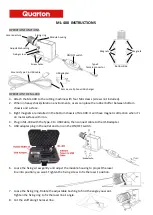
Part 1—The Diviner 2000 display unit and probe
Irrigation scheduling using Diviner 2000 data
Sentek Pty Ltd
ACN 007 916 672
Page 35
In
Phase 1
the change in volumetric soil moisture content is due to the
processes of drainage and evapo-transpiration. In
Phase 2
and
Phase 3
the
change is predominantly due to evapo-transpiration. The boundaries in
volumetric soil moisture content between
Phase 1
and
Phase 2
and
Phase 2
and
Phase 3
are defined respectively, as the Drained Upper Limit (DUL) or
Field Capacity
and the Lower Limit (LL) or
Onset of Crop Water Stress
.
Phase 1
occurs when soils are wetted to saturation, which means all soil
pores are filled with water. During
Phase 1
drainage through the profile
proceeds at a rate determined by soil structural attributes, slowing
appreciably after 1-2 days for most irrigated soils. However, much shorter
phases have been observed in coarse sands and longer phases in clays.
The soil moisture content of a profile can be monitored during
Phase 1
and
the start of
Phase 2
and plotted as a function of time (Figure 16). The time
when the soil is in a fully watered but drained state, can be identified. The
amount of water left in the root zone is called the
Field Capacity
.
Field
Capacity
is the moisture content after drainage of the gravitational water
and it is the upper limit of moisture held in the soil by capillarity.
Field
Capacity
is most important in adjusting the refill amount for a particular
soil type and depth of root zone in order to prevent over-irrigation.
The amount of water present during
Phase 2
is the difference between the
Field Capacity
and the
Onset of Crop Water Stress
. It is summed over the
plant rooting depth and called the
Readily Available Water Capacity
(RAWC)
, as distinct from
Plant Available Water (PAW). PAW
describes the
amount of water extracted by a crop between the
Field Capacity
and the
Permanent Wilting Point
. The
Permanent Wilting Point
is defined as the
soil moisture content at which the crop is subjected to irreversible wilting.
During
Phase 2
, water is freely and readily available to the crop, which
does not experience any stress.
RAWC
is preferred for use in irrigation scheduling because its defined
lower limit (
Onset of Crop Water Stress
) is an exact irrigation trigger index
of the crop that signals the onset of water stress from a crop’s point of
view. This is in contrast to the arbitrary index such as 50% threshold of
PAW
, which is an estimate and not a measurement of the crop’s water need.
Phase 3
shows a declining water use by the plant. The decline is specific to
each crop and corresponds to the onset of yield and/or quality reduction.
The boundary between
Phase 2
and
Phase 3
is the
Onset of Crop Water
Stress
. This is another key indicator for good irrigation management.
Summary of Contents for Diviner 2000
Page 6: ......
















































